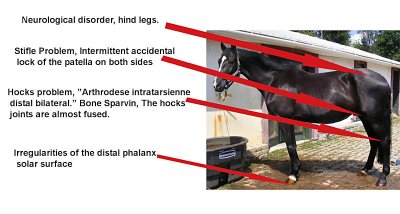The Medical Exam
Manchester
The Medical Exam
Manchester was presented at the Montreal University of Veterinary Medicine for complete assessment of his condition.
The exam diagnosed;

What can be done?
Stifle Problem. The stifle joint is stabilized between two main muscles on the outside and ligaments on the inside. Often this type of stifle problem results from imbalance between the tension created by the muscles and the ligaments. The two muscles are the quadriceps femora and a branch of the biceps femora. Proper tension can be recreated through gymnastic exercises developing the strength and tone of the Quadriceps and Biceps.
Other times the problem results from excessive rotation of the hind limb around the hip joint. The problem can be resolved increasing the dorso-ventral rotation of the pelvis. Frequently, stifle situations result from a combination of both issues. This will be a great opportunity to show how these gymnastics can be done.
Hocks problem. As the joints are fused, the reeducation will have to focus on the abnormal stresses that created the collapse between the joints. Finding the source will ease excessive strains on the hock joints. This will be a great opportunity to show and explain how hocks problems can be prevented
Irregularity of the solar surface of the distal phalanx
(Coffin Bone). The solar surface of the coffin bone is situated under the coffin bone. This issue will require a combined action between training and shoeing. The training will have to focus on reducing the weight on the forelegs. The shoeing will have to be done regularly, probably a four weeks period and the hoof will have to be well balanced. We will ask the farrier to explain his work.
Neurological problem of the hind legs. We have often observed that kinematics abnormalities were diagnosed as neurological when in fact they resulted from imbalance of the back muscles and consequent lateral or transversal deviation of the spine. Both, lateral bending and/or axial rotation will place the pelvis into an abnormal alignment in relation to the direction of the motion and consequently affect the kinematics of one or both hind legs. For example, the horse pictured here on collected trot was diagnosed as having a neurological problem. Previously the horse did not have any motion of the cranial thoracic vertebrae. If Manchester’s situation is about back muscles’ imbalance and consequent deviation of the spine, the problem might be fixable.
on collected trot was diagnosed as having a neurological problem. Previously the horse did not have any motion of the cranial thoracic vertebrae. If Manchester’s situation is about back muscles’ imbalance and consequent deviation of the spine, the problem might be fixable.
--------------
Execution and documentation of such reeducation are costly. Helping us financially may give you in return a knowledge that will save much greater expenses. For each issue, we will complete the documentation with references to other horses that presented similar problems and have been reeducated.


